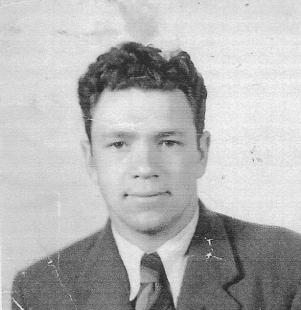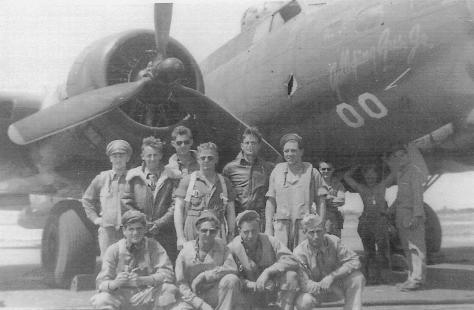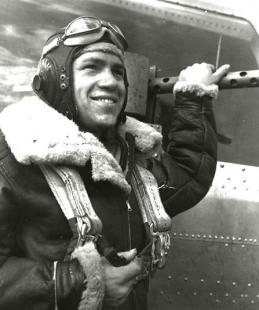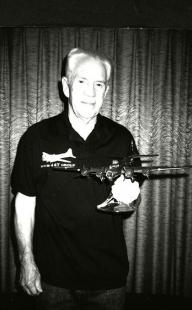William M. Beste
Era: World War II
Military Branch: Army




Photo 1: Mr. Beste in civilian clothing, in case he was shot down. Photo 2: Mr. Beste with his crew. Photo 3: Mr. Beste in his flight jacket Photo 4: Mr. Beste, later in life
William H. Beste
William M. Beste enlisted in the Army Air Corps on May 11, 1942, Minneapolis, Minnesota.
He served as a Technical Sergeant, radio operator, and gunner aboard B-17 bombers with the 708th Bomb Squadron of the 447th Bomb Group (M), Eighth Air Force based at Rattlesden, England.
In his words: "I flew 31 combat missions over German-occupied Europe from June to October with B-17 crew ''Jocko.'' This crew assembled in January 1944, at McDill Field, Fla., with 10 members from the following states: Maine, Maryland, Delaware, New Jersey, Connecticut, Pennsylvania, Arizona, Minnesota, Wisconsin and New York. Assigned to B-17s at Hunter Field, Ga., and flew to North Ireland. Pilot killed on first mission, crew assigned new pilot and co-pilot. Strategic missions include Northern and Southern France, Berlin, Leipzig, Munich, Bremen, and Rhineland. Assisted ground forces of U.S. and Britain across Europe, Holland, Belgium, etc."
Returned to U.S. in 1944 and served as gunnery instructor. "Assigned to turret gunner school for B-29s. Assigned again to full time flight duty at Pueblo, Colorado, as war ended. Also flew missions on the original "Fuddy Duddy." Restored B-17 Fuddy Duddy is now at Geneseo, NewYork, National Warplane Museum. No injuries, no wounded although aircraft was badly shot up by flak several times."
Awarded: Distinguished Flying Cross, Air Medal with three Oak Leaf Clusters (representing three subsequent awards of this decoration), Good Conduct Medal, European-African-Middle Eastern Medal, and one overseas service bar.
Honorably discharged October 2, 1945, Truax Field, Wisconsin.
Source: Hometown Heroes: The Saint Louis County World War II Project, page 37.
William H. Beste
Mr. Beste served in World War II in the European Theater. He enlisted in the U.S. Army Air Forces in May 1942 and began serving on October 15, 1942. He was assigned to the 447th Bomb Group, 708th Bomb Squadron, 8th Air Force, based in England.
He was part of the Jocko crew, and they flew in several different aircraft. Mr. Beste flew in 31 missions between May 29 and October 6, 1944. He was discharged on October 2, 1945. Members of his unit carried photographs of themselves in civilian clothing in case they were shot down. Mr. Beste was a Radio Operator/Gunner.
His rank was Technical Sergeant. Mr. Beste was decorated with the Distinguished Flying Cross, the Air Medal with three Oak Leaf Clusters, the Good Conduct Medal, the European-African-Middle East Service Medal, and an overseas service bar.
Mr. Beste was born in 1922 in Virginia, Minnesota. He is the son of August A. and Nettie L. Beste. He graduated from Virginia High School in 1940.
Source: Veterans’ Memorial Hall veteran history form; veteran’s account (below);
“In Uniform: Fortress Gunner Beste Gets DFC,” Virginia Daily Enterprise, November 20, 1944 (below); and the original entry on the VMH website (below)
“447th Bomb Group, 708th Squadron radio operator gunner (ROG), B-17 bomber, Rattlesden Airbase, England, crew Jocko. “Our pilot, Lt. Lowell F. Simmons, died on his first (indoctrination) mission with another crew, June 21, 1944. Bailed out when plane on fire. Jocko crew intact with replacement pilots: Lts. Lakeman, Noonan, Zammett. “Two crews, Leitch and Bowers, quartered with us, were also shot down. Many losses.” ----- “In Uniform: Fortress Gunner Beste Gets DFC,”
Virginia Daily Enterprise, November 20, 1944: “An Eighth Air Force Bomber Station, England—Technical Sergeant William H. Beste, 22, of Virginia, Minn., has been awarded the Distinguished Flying Cross for ‘extraordinary achievement’ as a radio operator and gunner on a B-17 Flying Fortress during the Eighth Air Force attacks on industrial and military targets in Germany.
“Sgt. Beste is a member of the 447th Bomb. Group, a unit of the 3rd Bomb. Division, the division that was cited by the President for the now historic England-Africa shuttle bombing attack on the Messerschmitt plant at Regensburg, Germany.
“He has taken part in many attacks on vital military targets in Aachen, Dusseldorf, and Cologne that prepared the way for the entry of American troops into Germany. In addition, he flew with the Eighth Air Force when they attacked the oil refineries in Merseburg and Leipzig and the marshalling yard in Munich.
“The DFC was presented by Sgt. Beste’s commanding officer, Lt. Colonel William J. Wrigglesworth of Eau Claire, Wis. The official citation accompanying the award commented on the ‘courage, coolness and skill’ shown by the Virginia gunner during his many missions over Nazi-held Europe.“
In addition to the DFC, he holds the Air Medal and three Oak Leaf Clusters to the Air Medal.
“The son of Mr. and Mrs. August Beste, of Virginia, Sgt. Beste was graduated from Virginia High School in 1940. Before entering the Army Air Forces in May 1942, he was employed as a printer at the Little Press, Inc., in Minneapolis. He received his gunner’s wings in January 1944, at Las Vegas, Nev., gunnery school.”
Original entry on VMH website:
William M. Beste enlisted in the Army Air Corps on May 11, 1942. He was a technical sergeant and a radio operator and gunner aboard B-17 bombers with the 708th Bomb Squadron, 447th Bomb Group (M), 8th Air Force, based at Rattlesden, England. In his words: "I flew 31 combat missions over German-occupied Europefrom June to October with B-17 crew ''Jocko.'' This crew assembled in January 1944 at McDill Field, Fla. with 10 members from Maine, Maryland, Delaware, New Jersey, Connecticut, Pennsylvania, Arizona, Minnesota, Wisconsin and New York.We were assigned to B-17s at Hunter Field, Ga. and flew to North Ireland. The pilot was killed on the first mission, crew assigned new pilot and co-pilot. Strategic missions include northern and southern France, Berlin, Leipzig, Munich, Bremen and the Rhineland. We assisted ground forces of U.S. and Britain across Europe, Holland, Belgium, etc." He returned to U.S. in 1944 and served as gunnery instructor, and then was "assigned to turret gunner school for B-29s. Assigned again to full-time flight duty at Pueblo, Colo., as the war ended. Also flew missions on the original "Fuddy Duddy." A restored B-17 Fuddy Duddy is now at Geneseo, NY., in the National Warplane Museum. No injuries, no wounded --although aircraft was badly shot up by flak several times."
He received the Distinguished Flying Cross, Air Medal with three Oak Leaf Clusters, Good Conduct Medal, European-African-Middle East Service Medal and an overseas service bar.
He was discharged on Oct. 2, 1945.

